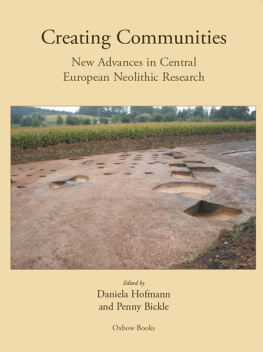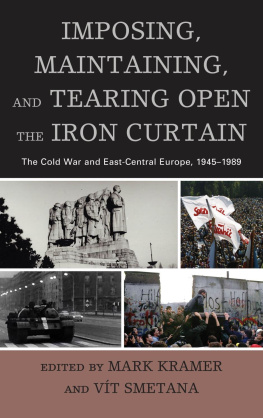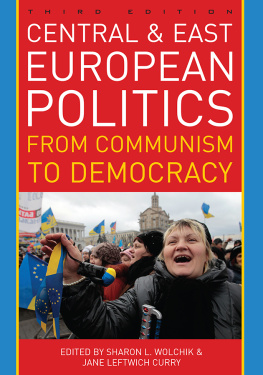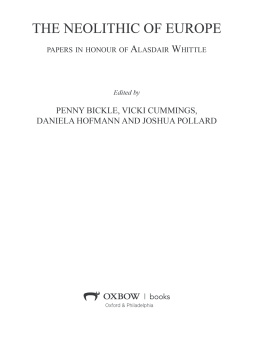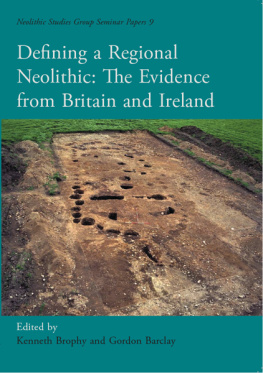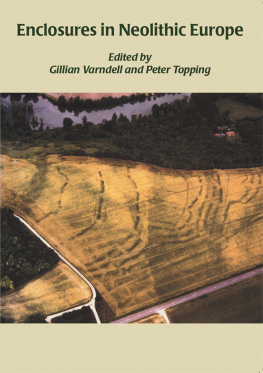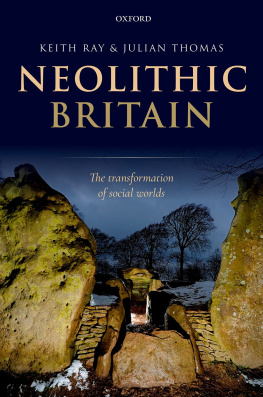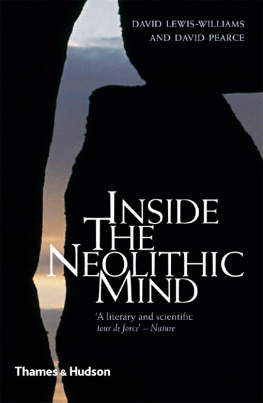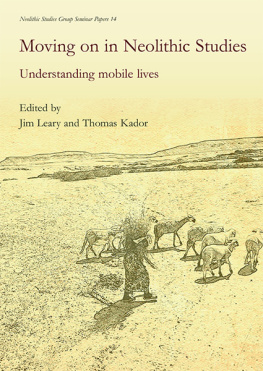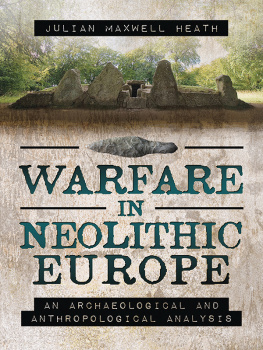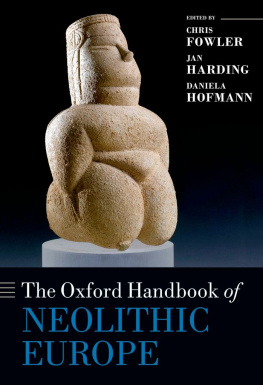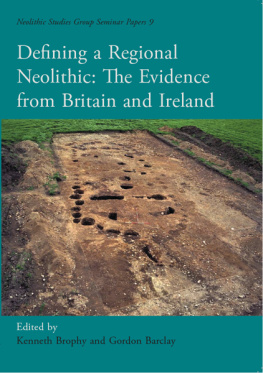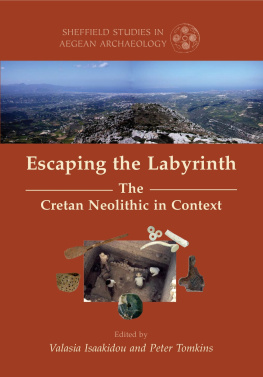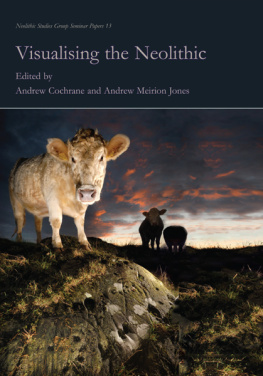Published by
Oxbow Books, Oxford
Oxbow Books and the individual authors, 2009
ISBN 978-1-84217-353-4
EPUB ISBN: 978-1-78297-328-7
PRC ISBN: 978-1-78297-329-4
This book is available direct from
Oxbow Books
Phone: 01865-241249 Fax: 794449
and
The David Brown Book Company
PO Box 511, Oakville, CT 06779, USA
Phone: 860-945-9329; Fax: 860-945-9468
or from our website
www.oxbowbooks.com
Library of Congress Cataloging-in-Publication Data
Creating communities : new advances in Central European neolithic research / edited by Daniela Hofmann and
Penny Bickle.
p. cm.
ISBN 978-1-84217-353-4
1. Bandkeramik culture. 2. Neolithic period--Europe, Central. 3. Neolithic peoples--Europe, Central. 4. Europe,
Central--Antiquities. 5. Excavations (Archaeology)--Europe, Central. I. Hofmann, Daniela. II. Bickle, Penny. GN776.2.B3C74 2009
943--dc22
2009018086
Cover image: an LBK longhouse at Wang, southern Bavaria, during excavation in September 2008.
Photo: Alasdair Whittle
Printed in Great Britain by
Hobbs the Printers Ltd, Totton, Hampshire.
Contents
Penny Bickle and Daniela Hofmann
Luc Amkreutz, Bart Vanmontfort and Leo Verhart
Marc Lodewijckx, with Corrie Bakels
Olga V. Larina
Joanna Pyzel
Britta Ramminger
Erich Claen
Lisandre Bedault
Penny Bickle
Corina Knipper
Oliver Rck
Joachim Pechtl
Andrea Zeeb-Lanz, Rose-Marie Arbogast, Fabian Haack, Miriam N. Haidle, Christian Jeunesse, Jrg Orschiedt, Dirk Schimmelpfennig and Samuel van Willigen
Daniela Hofmann
Anna Rauba-Bukowska
Alasdair Whittle
Contributors
Luc Amkreutz
National Museum of Antiquities (Rijksmuseum van Oudheden)
Papengracht 30, Postbus 11114
NL 2301 EC Leiden
Rose-Marie Arbogast
Institut fr Prhistorische und
Naturwissenschaftliche Archologie (IPNA)
University of Basel
Spalenring 145
CH 4055 Basel
Corrie Bakels
Faculty of Archaeology
University of Leiden
Reuvensplaats 34
NL 2311 BE Leiden
Lisandre Bedault
Universit de Paris 1 Panthon-Sorbonne
CNRS UMR 7041, ArScAn, Protohistoire Europenne
Maison de lArchologie et de lEthnologie
21, alle de lUniversit
FR 92023 Nanterre Cedex
Penny Bickle
School of History and Archaeology
Cardiff University
Humanities Building, Colum Drive
UK Cardiff CF10 3EU
Erich Claen
Bayerisches Landesamt fr Denkmalpflege
Dienststelle Ingolstadt
Unterer Graben 37
DE 85049 Ingolstadt
Corina Knipper
Eberhard-Karls-Universitt Tbingen
Institut fr Ur-und Frhgeschichte und Archologie des Mittelalters
Naturwissenschaftliche Archologie
Rmelinstr. 23
DE 72070 Tbingen
Olga Larina
Institutul Patrimoniului Cultural
Str. Banulescu Bodoni 35
MD-2012 Chisinau
Marc Lodewijckx
Department of Archaeology and Art History
University of Leuven
Blijde Inkomsstraat 21, bus 3313
B 3000 Leuven
Fabian Haack
Generaldirektion Kulturelles Erbe Rheinland-Pfalz
Direktion Archologie Speyer
Kleine Pfaffengasse 10
DE 67346 Speyer
Miriam Haidle
Intitut fr Ur- und Frhgeschichte und Archologie
des Mittelalters
Abt. ltere Urgeschichte Quartrkologie
Schloss, Burgsteige 11
DE 72072 Tbingen
Daniela Hofmann
School of History and Archaeology
Cardiff University
Humanities Building, Colum Drive
UK Cardiff CF10 3EU
Christian Jeunesse
MISHA
Universit Marc Bloch Strasbourg II
5, alle du Gnral Rouvillois
FR 67083 Strasbourg Cedex
Jrg Orschiedt
Archologisches Institut
Universitt Hamburg
Edmund-Siemers-Allee 1, Flgel West
DE 20146 Hamburg
Joachim Pechtl
Rotkehlchenweg 14c
DE 82538 Geretsried
Joanna Pyzel
Institute of Archaeology
Gdask University
al. Bielaska 5
PL 80-851 Gdask
Britta Ramminger
Archologisches Institut
Universitt Hamburg
Edmund-Siemers-Allee 1, Flgel West
DE 20146 Hamburg
Anna Rauba-Bukowska
AGH University of Sciences and Technology
PL 30-059 Krakow
al. Mickiewicza 30
Oliver Rck
Prhistorische Archologie
Institut fr Kunstgeschichte und Archologien Europas
Martin-Luther-Universitt Halle-Wittenberg
Brandenbergweg 23c
DE 06120 Halle (Saale)
Dirk Schimmelpfennig
Institut fr Ur- und Frhgeschichte
Universitt zu Kln
DE 50923 Kln
Bart Vanmontfort
Eenheid Prehistorische Archeologie
Geo-instituut
Celestijnenlaan 200e bus 2409
BE 3001 Leuven
Samuel van Willigen
Swiss National Museum
Department of Archaeology
Museumstrae 2
CH 8023 Zrich
Leo Verhart
Limburgs Museum
Keulsepoort 5
NL 75911BX Vento
Alasdair Whittle
School of History and Archaeology
Cardiff University
Humanities Building, Colum Drive
UK Cardiff CF10 3EU
Andrea Zeeb-Lanz
Generaldirektion Kulturelles Erbe Rheinland-Pfalz
Direktion Archologie Speyer
Kleine Pfaffengasse 10
DE 67346 Speyer
Introduction: researching across borders
Penny Bickle and Daniela Hofmann
Introduction
Unquestionably, the LBK is one of the best researched Neolithic cultures in Europe. Substantial information on architecture, settlement patterns, economic behaviour, exchange and mortuary rites is available, and the quantity of excavation and specialist reports, theses and micro-regional studies in various European countries now escapes easy overview. Why, then, this book?
This volume originated at a 2006 EAA session at Krakow entitled Advances in Central European Neolithic research which aimed to provide a forum for PhD students and newly established researchers to present their ideas to a wider audience, sharing approaches across traditional research boundaries. As the field becomes much more specialised, it is often hard to keep track of where research concerns converge. In the course of the session, it became clear that presentations consistently raised certain key themes which cross-cut, but also reinforced some of the established research foci. These can best be characterised as the nature and interplay of various scales of social interaction and the linked concern with identities, be they individual, local, regional, or ethnic and culture-wide.
The aims of this book are hence not only to make a wealth of scattered material in various European languages available to an English-speaking audience, but also to raise more fundamental questions about the investigation of identity, community and change in prehistory. The nature and quality of the LBK material invites reflection on how different scales of social life can best be interconnected. Moddermans (1988) dictum of diversity in uniformity for the LBK is frequently quoted, but we are still grappling to explain the social mechanisms behind these patterns. How can LBK material culture be so instantly recognisable and comparable over vast geographical areas and over half a millennium, while at the same time showing regional variations in almost every respect? How are these similarities and differences negotiated at various social levels?
One reason for archaeologys persistent problems in explaining this point is the dominant and pervasive tendency to think in neatly packaged, bounded building blocks of social interaction: beginning with the individual and working our way up via the household, settlement, settlement cell and micro-region to larger regions and eventually the culture. All these elements function a bit like Lego bricks, where several small ones can be connected together to form the next largest entity, but without their own boundaries being questioned in the process. Traditionally there has been a tendency to aim modelling at the top tiers of this hierarchy of bricks: at social structure and even culture-wide norms. It is here that we saw the need to depart from the established canon to open up new trajectories of investigation, but without creating an artificial focus on just the small scale. To be successful, LBK archaeology needs to embrace a variety of approaches and voices, and this is what the volume represents.
Next page
